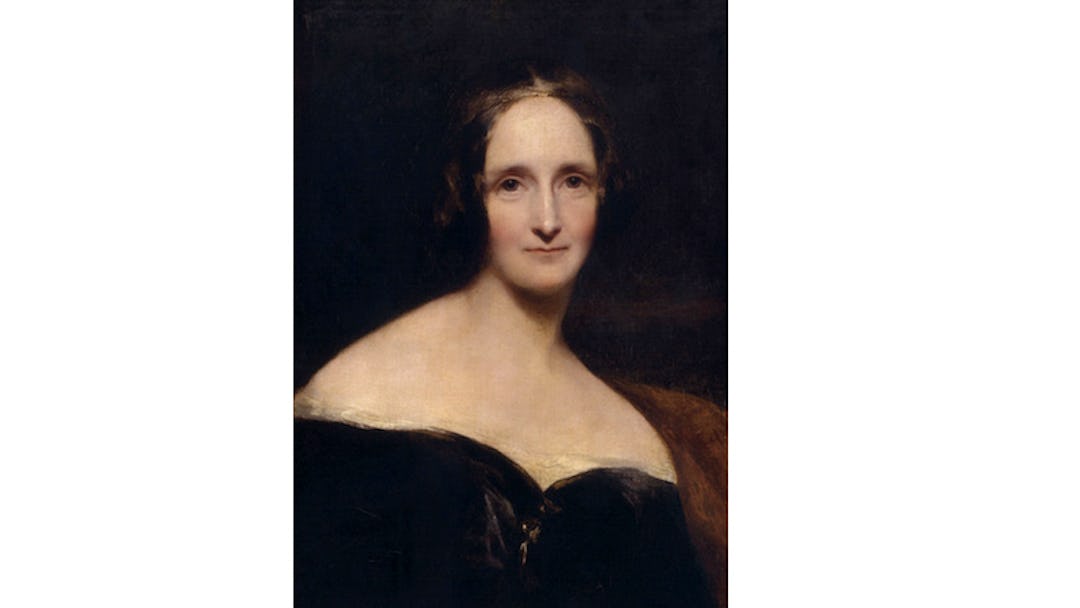In honor of Valentine’s Day, Flavorwire is deconstructing a few famous pop-culture romances. Here’s our first effort, on Mary and Percy Shelley.
You know, people present the romance of Mary and Percy Shelley as one of history’s great love stories. Possibly because it involved a sudden elopement, and sudden elopements seem so romantic in theory. But they are often just flat-out crazy in practice.
To consider, for starters: Mary (then-Wollstonecraft Godwin) was 16 when she snuck off to meet her future husband, Percy Shelley. They were acquainted through her father, but that rendezvous would be their first tryst. And it would happen in a graveyard. Taken alone, that would be ghoulish enough, as first dates go. But this particular graveyard had, as one of its inhabitants, Mary’s own famous suffragette mother, Mary Wollstonecraft. The symbolism of standing over your dead mother as you profess your love for a hot young poet: tough to ignore. Though the drama of the atmosphere certainly let you ignore that the hot young poet is already married, and expecting a child.
Shelley was 21 himself, so not that much older and certainly not much wiser. He almost instantly slept with Mary (possibly in the cemetery, Miranda Seymour’s recent biography speculates, though who knows), and within two weeks had announced his affections to Mary’s father. Shockingly, the elder Godwin, who had counted Shelley a friend, was less than pleased at these developments. He tried to place himself between Shelley and the “fair and spotless fame of my young child.” He was foiled by his other daughters, one of whom was helping run love notes back and forth between the lovers. Jane had also been a chaperone on that night (or those nights) in the graveyard, though she was more accomplice than hall monitor, obviously.
Meanwhile, Shelley told his wife, Harriet, in a letter that he would continue to be friendly but that she must consider Mary’s own suffering, and “the tyranny which is exercised upon her,” meaning, it seems, Godwin’s control over his daughter. The man had balls, telling his pregnant wife to sympathize with his mistress of perhaps a month’s standing. He began to make financial plans to leave Harriet, plans no doubt made easier by the fact that Shelley was an endless borrower from his father’s estate.
Never one to stick to the practicalities, this plan-making did not prevent Shelley from, on at least two occasions, threatening suicide by laudanum. At least once, he tried to induce Mary herself to do the same in a sort of misbegotten Romeo-and-Juliet drama. Finally, he hatched a plan that they would leave and go abroad, and Mary dashed to the end of a street after a chaise, trailing Jane too, running in black silk ball gowns. It was under two months after the first night in the cemetery and the thing had already gone all to hell. Though Shelley was happy, and even toying with the idea of eventually having Harriet join them when the trio settled in continental Europe.
The thing he might not have known then, as they rushed to Dover to sail across the English channel, was that Mary was already pregnant.
She would eventually miscarry that child. Bad childbirths became a theme of her life, possibly one reflected in the fleshy grostesqueness of Frankenstein, as Ruth Franklin has speculated. Of the five pregnancies she’d have in the four years she’d be with Shelley, only one child would actually survive.
In fact, most things, after the pretty elopement, went sour. Jane, who continued to live with the couple for some time, changed her name to Claire and promptly began to deeply annoy Mary by carrying on what was at least an emotional affair with Shelley.
Harriet Shelley committed suicide a couple of years later.
Godwin’s former financial stability began to evaporate, and he reconciled with his daughter just in time to become a financial burden on her.
Shelley’s interest in Mary herself began to wane.
And then Shelley died in a sailing accident, and his family refused to support Mary or the one surviving child of the alliance, William.
Appropriately, though, for someone whose romantic life hit its peak in a graveyard, she managed to keep his heart, cut from the decaying body they took from the sea. Later, she burned it with Shelley’s friends on a pyre. (The apocrypha holds that Shelley was a bit afraid of being buried alive, and had often hoped for this.) After Mary died, Seymour notes, what remained of the heart was found among her things, wrapped in silk. People like to think of this as a melodramatic testament to the lastingness of their love.
That, I think, is a bit of a teenager’s interpretation. Let me offer another counterintuitive reading, one which I have no real evidence for — but, I think, with a life of melodramatic boyfriends behind me, I do have some authority to offer. See, as for myself, I like to think there were nights when she saw keeping his heart imprisoned in a drawer so long after he was gone as a sort of payback, for his taking her own at such a young age. There is a level on which it all sounds like revenge.
